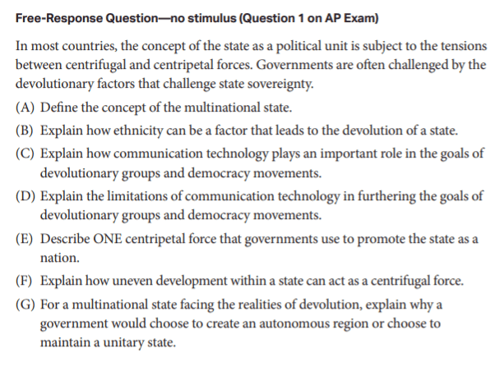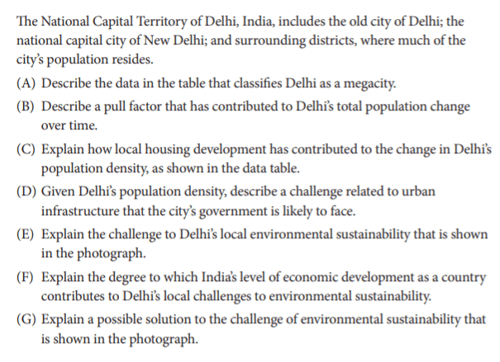
The free-response section is the hardest part of any AP test. Although AP Human Geography is much more straightforward than some other humanities AP exams, if you don’t have your stuff down, the free-response section can still hit you where it hurts.
In this article, we’ll go through the structure of the free-response section, some helpful tips for answering AP Human Geography FRQs, examples of what these free-response questions look like, and a few places where you can find the best practice materials.
AP Human Geography Free Response Section Format
There are three questions on the free-response section, each worth 7 raw points. You’ll get one hour and 15 minutes to answer all three questions, or about 25 minutes per question. Your free-response score accounts for half your AP Human Geography test score (the other half comes from your multiple-choice section score).
Here’s what you must do for each question, according to the College Board:
- Describe, explain, apply geographic situation or scenario (no stimulus)
- Describe, explain, apply geographic data using data, image, or map (one quantitative or qualitative source)
- Describe, explain, apply geographic data using data, image, and/or map (two sources, qualitative and/or quantitative)
Note that a “stimulus” is a quantitative or qualitative source, such as a chart or table. As you can see above, you’ll get no source for question 1, one for question 2, and two for question 3.
How to Answer AP Human Geography FRQs: 4-Step Guide
Before we get into examples with answer explanations, let’s go over the essential steps you must take in order to effectively answer these types of questions.
AP Human Geography free-response questions are typically pretty straightforward so you can attack them in a methodical fashion. Here’s a sample question from the 2020 Course and Exam Description that I’ll use as a reference so you can see how the different steps apply:

Step 1: Read the Introductory Statement
Before you start in on the first part of the question, be sure to read the short introductory blurb. It sets up the topic you’ll be analyzing and gives you firmer ground to stand on when addressing the rest of the question.
In the sample question above, the introductory statement makes it clear that the question will deal with states, national governments, and tensions between the two.
Reading all the introductory statements for the three free-response questions in the section before you start answering any of the individual parts can help you decide where to begin. If you see a topic that is especially familiar, you might go for that question first as you’ll be able to answer it the fastest.
Step 2: Identify the Task Verb (and Understand What It Means)
In each part of the question (A-G), it’s a good idea to underline the specific task verb at play, that is, what it’s asking you to do. This should help you keep yourself on track when responding to the question. Identifying these verbs will also get you in the habit of paying closer attention to the differences between each of the tasks.
Here are the most commonly used task verbs on the exam, according to the College Board:
Compare: Provide a description or explanation of similarities and/or differences.
Define: Provide a specific meaning for a word or concept.
Describe: Provide the relevant characteristics of a specified topic.
Explain: Provide information about how or why a relationship, process, pattern, position, or outcome occurs, using evidence and/or reasoning.
Identify: Indicate or provide information about a specified topic, without elaboration or explanation.
For example, a question that asks you to “identify” something will merit a much more succinct answer than one that asks you to “describe” it.
In part A of the sample question, the key command is “define,” meaning you could just give a one-sentence answer that clearly outlines what a multinational state is. In part E, the task verb is “describe,” which denotes a longer answer that elaborates on an example of a centripetal force that governments use.
Finally, parts B, C, D, F, and G all use the command verb “explain,” which means you will really have to go into detail to earn a point for each part of the question.
Ultimately, you’ll save time and earn points if you’re careful to make these distinctions among task verbs!
Step 3: Reread and Double-Check Your Answer
Once you’ve finished writing your answer, reread the question and your response to make sure you’ve done everything it asked you to do. If you’re satisfied, move on to the next part of the question, and repeat the process of identifying task verbs and trying to get the full point offered at each part of the question (always labeled A-G).
After you finish the last part of a particular free-response question, check over all your answers for that question one last time to ensure that everything is the way you want it to be. Then you can move on to the next free-response question.
Step 4: Pace Yourself
This is more of a general tip for the AP Human Geography test, but as you work through the three free-response questions, make sure that you’re keeping track of time and pacing yourself.
As a reminder, you’ll have one hour and 15 minutes to complete three FRQs. This means you’ll get about 25 minutes per question; however, it’ll be better for you to try to complete each question within 20 minutes. This way you’ll have some extra time at the end to go back and look over your answers and tweak them if needed.

Review your answers with a second, more critical eye. I think this picture is photoshopped, but I don’t know for sure because I don’t feel like Googling, “Can you have two pupil/iris combos within one eyeball?” Just kidding, I did Google it, and it’s probably not a thing, but not even the internet knows for sure. OoOoOoOo.
One of the single most important parts of your college application is what classes you choose to take in high school (in conjunction with how well you do in those classes). Our team of PrepScholar admissions experts have compiled their knowledge into this single guide to planning out your high school course schedule. We’ll advise you on how to balance your schedule between regular and honors/AP/IB courses, how to choose your extracurriculars, and what classes you can’t afford not to take.

AP Human Geography FRQ Example + Answers
In this section, we’ll go through the answer to a sample free-response question from the 2020 AP Human Geography Course and Exam Description.


This question is an example of question 3 on the Human Geography exam. As you can see, there are two stimuli (a table and a photograph) and seven parts (A-G), each worth 1 point.
In order to earn full credit, here is what you’d need to write down as your answer, per the official scoring guidelines. (Note that there are multiple possible answers you could put down for A-G.) As always, pay careful attention to the task verbs being used!
(A) Answer Options
- Delhi is classified as a megacity because it has a total population greater than 10 million.
- From 1991 to 2011, Delhi’s total population grew to over 10 million.
(B) Answer Options
Many people move to Delhi from rural areas and smaller cities …
- in search of employment opportunities.
- in the hopes of improving their income or quality of life.
- to join family members or friends already living in Delhi.
- to have better access to services, health care, or education.
(C) Answer Options
- The city’s center increases in the size, height, and/or number of large apartment buildings and condominium that attract a growing population of middle-class workers in the country’s capital.
- Infilling occurs where open space presents an economic opportunity for landowners to build small multi-family housing units, placing more people into existing city blocks.
- The government is increasing its provision of public housing in apartment blocks within the city, which provide larger buildings with multi-family housing units.
Looking for help studying for your AP exam?
Our one-on-one online AP tutoring services can help you prepare for your AP exams. Get matched with a top tutor who got a high score on the exam you’re studying for!

(D) Answer Options
- A need for additional public transportation lines and/or added capacity on existing transit systems.
- A need for improved sanitation, water supply, waste disposal, or wastewater treatment facilities.
- A need for more housing, especially for lower-income residents.
- A need for improved communication or electric utility infrastructure.
- A need for additional public schools, colleges, universities, and/or libraries.
(E) Answer Options
Increased number of vehicles on the roadways results in visible air pollution, fog, smog, and/or airborne chemicals that lead to …
- health problems.
- transportation accidents.
- diverting potential economic investment in the city.
(F) Answer Options
- India is a less developed country which has limited government funding to pay for pollution abatement programs (such as alternative fuels) or large investments in public transit.
- India has a growing industrial sector which has limited environmental regulations such as controls on air pollution. Industrial air emissions contribute to the city’s air pollution levels.
- India has a large rural population and urban poor population who are dependent on burning wood for home heating and cooking. The smoke increases the city’s air pollution levels.
- During the dry season, farmers in northern India will burn the dead vegetation in their fields (following the harvest) to improve soil nutrients. The smoke can increase the city’s air pollution levels.
- As India’s economy grows, more people can afford to own cars or buy trucks for their businesses. The additional vehicle increases the total amount of air pollution.
(G) Answer Options
- Transportation-oriented development of new housing, industrial and retailing areas. Or, laws requiring new developments be constructed with bus lanes, train lines, and stations.
- Vehicle restrictions, high-occupancy requirements, tolls, or congestion pricing to limit the number of vehicles on the roads.
- Smart-growth policies, slow-growth, or zoning policies that restrict the amount of land that can be developed or create a development boundary or greenbelt around the city.
- Alternative electrical energy and/or alternative fuel programs that are cleaner-burning or have zero emissions.
- New Urbanism or mixed land-use developments where workers live, shop, and work within walkable distances.
How to Practice AP Human Geography FRQs
You can find plenty of AP Human Geography free-response questions (and their corresponding answer guidelines) online.
The College Board maintains a collection of real free-response exam questions that were administered between 2001 and 2021 with sample responses and scoring guidelines. This is the best resource for FRQs because you can rest assured that they’re accurate representations of what you’ll see on the exam in terms of content and difficulty level.
While there’s nothing wrong with using free-response questions crafted by test-prep companies for preliminary practice, you should always incorporate official questions into your studying at frequent intervals.
Other free options include high-quality, unofficial practice tests. Check out our guide to all AP Human Geography practice tests you can use for tips on what to prioritize in your prep.
 It’s time to fly free! Go, respond. It is your destiny.
It’s time to fly free! Go, respond. It is your destiny.
What’s Next?
Want an overview of the whole AP Human Geography exam with examples of both multiple-choice and free-response questions? Then take a look at our expert guide to Human Geography.
Looking for more resources to use in preparing for this tricky AP test? Check out my ultimate study guide for AP Human Geography!
If you want more free-response practice, then you might consider getting an AP review book to supplement the online resources listed in this article. Here is a list of the best review books for AP Human Geography.

Want to build the best possible college application?
We can help. PrepScholar Admissions is the world’s best admissions consulting service. We combine world-class admissions counselors with our data-driven, proprietary admissions strategies. We’ve overseen thousands of students get into their top choice schools, from state colleges to the Ivy League.
We know what kinds of students colleges want to admit. We want to get you admitted to your dream schools.
Learn more about PrepScholar Admissions to maximize your chance of getting in.

Source: blog.prepscholar.com